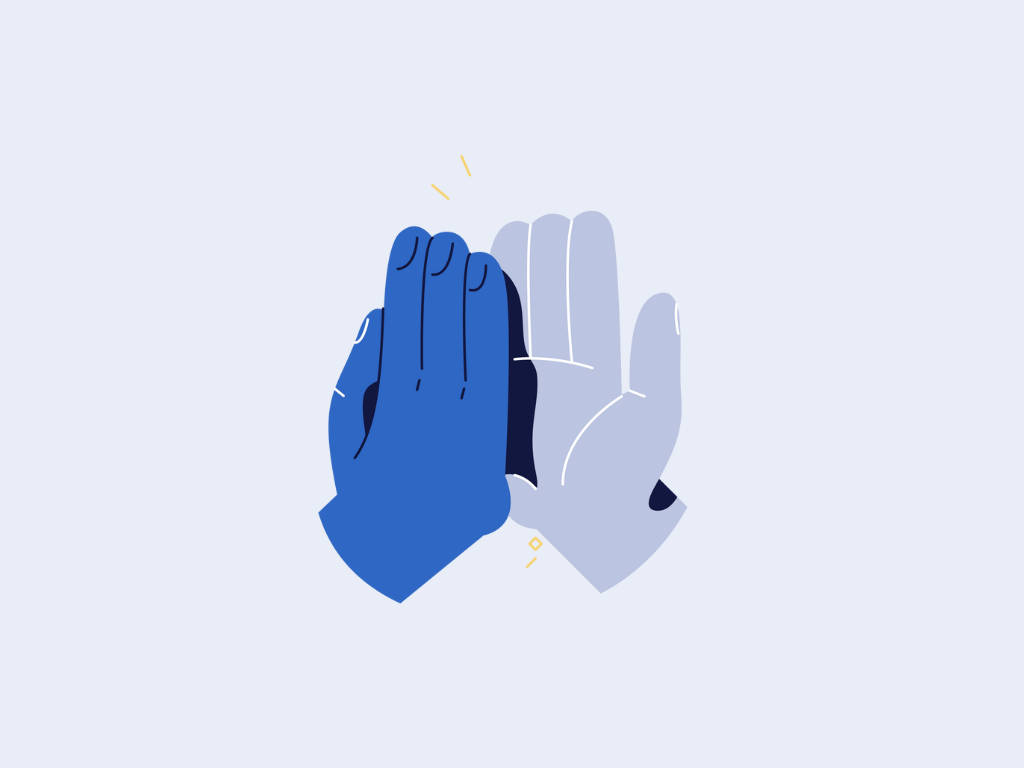Great Google Ads results start on the whiteboard—not in the interface. Elite agencies map your funnel, then cluster keywords into tight, single-intent ad groups. That structure alone can cut cost per click by 16–50 percent because Google lowers bids as Quality Score rises.
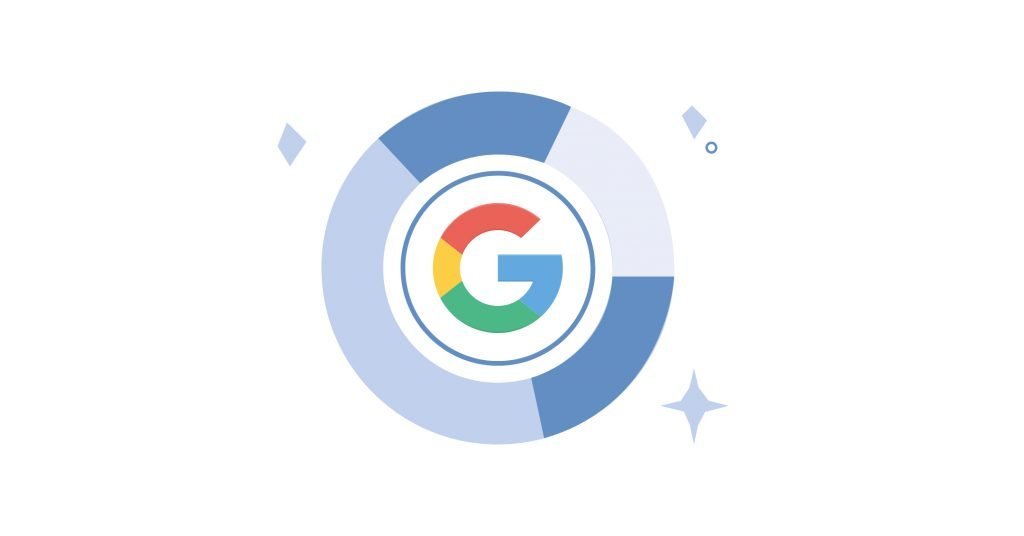
What Makes an Agency Great at Slashing CAC?
1. Expertise & strategy
Next, strategists pressure-test every rollout—Performance Max, Demand Gen, and the latest beta—against your CAC targets. They run experiments in their own accounts first, so wins or losses surface in days, not weeks, and the budget never bleeds across the account.
Deliberate architecture, paired with disciplined testing, sets the foundation for every cost-saving tweak that follows; even the smartest bid rules can’t fix a messy structure.
2. Data-driven optimization
After the account architecture is in place, elite teams let the numbers dictate every next move. Analysts review cost-per-conversion and impression-level data daily, then adjust bids or pause ad groups the moment a metric drifts above target.
Automation helps, yet the human layer protects margin. In one finance campaign, hourly bid rules and device-level modifiers trimmed cost per acquisition by 14 percent while new-customer volume rose 17 percent, according to WordStream. Senior analysts replicate similar experiments week after week, comparing Smart Bidding output with real CAC targets and overriding the algorithm whenever spend creeps past the ceiling. That discipline mirrors how PPC Masterminds, a Los Angeles based PPC agency, structures its management approach: daily account reviews, Looker Studio dashboards, and revenue tracking that ties every optimization back to customer acquisition cost.
Top performers never settle for aggregate views. They segment results by audience, device, and even hour of day to uncover micro-pockets where clicks are cheap yet conversion-prone. Each insight fuels a new test, and each test feeds the next budget shift, creating a compounding loop that drives CAC lower every cycle.
3. Creative that converts, CRO that seals the deal
Targeting earns the click; persuasive creative earns the customer. Top agencies treat headlines and images as living assets, shipping fresh variants every week and retiring losers fast. Even a 0.1-point lift in click-through rate can reduce cost per click by up to 20 percent, according to WordStream.
But the ad is only half the story. When Unbounce tested a new headline for a travel brand, the landing-page conversion rate jumped 104 percent in 23 days, according to Unbounce. Doubling conversions effectively halves CAC without additional budget.
High-performing teams run that loop on repeat:
- Launch fresh ad copy or imagery.
- Pair it with an A/B-tested landing page.
- Promote the winner, archive the rest.
By the time creative fatigue creeps in, the next variant is already queued, keeping Quality Scores high, CPCs low, and acquisition costs trending down.
4. Radical transparency and relentless iteration
Trust grows when numbers are visible to everyone, all the time. Elite agencies surface live dashboards that track clicks, conversions, true CAC, and lifetime value, so strategy calls shift from “What happened?” to “What’s next?”
That openness accelerates results. The Honest Company used Google Ads campaign experiments with real-time scorecards to iterate twice as fast and lift return on ad spend by 47 percent while cutting setup time in half, according to Think with Google. Tok-Shop saw a similar pattern: automating reports and weekly optimizations freed 35 percent of analyst hours and increased ROAS 10 percent, also according to Think with Google.
Top agencies follow the same cadence. If cost per acquisition creeps above target on Wednesday, bids get trimmed before the next morning’s coffee. New ad copy is queued while the current variants still gather data, so creative fatigue never inflates costs.
When radical transparency meets rapid iteration, performance does not plateau; it compounds. The savings appear in the only metric that matters: the dollars you spend to win each new customer.
The 7 PPC Agencies Proven to Cut Customer Acquisition Cost
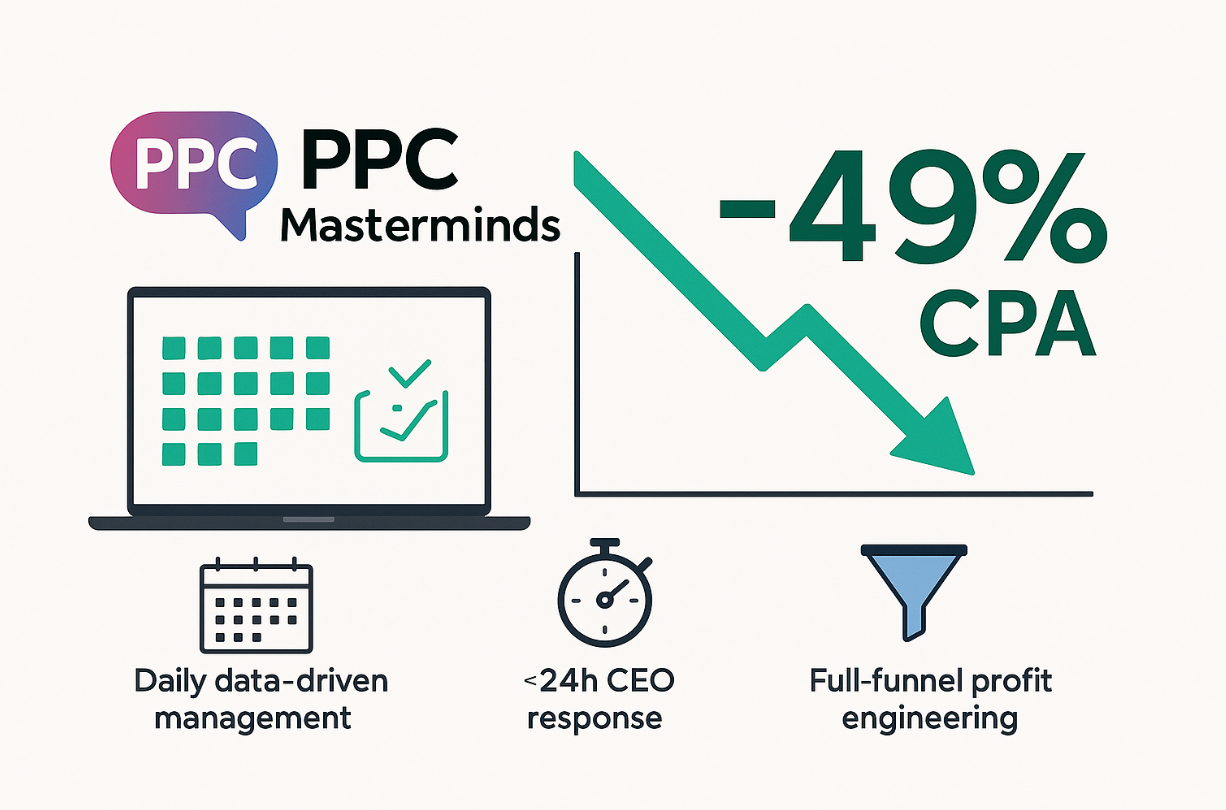
1. PPC Masterminds: data-driven partner that halves CAC
Los Angeles boutique, founded 2014. The senior-only team runs your paid search like an investment, not an expense. Multi-platform chops (Google, Meta, LinkedIn, Microsoft), plus CRO, landing pages, SEO, email, and analytics to squeeze profit from every click. Clients stay 5+ years and engagements run without contracts, backed by an all 5-star track record at PPC Masterminds.
Why they stand out
- Direct CEO involvement. Founder & Google-Certified strategist Zaid Ammari reviews accounts daily and replies in < 24 hours.
- Daily, data-driven management. Real-time Looker Studio dashboards + weekly handwritten insights = radical transparency.
- Full-funnel profit engineering. Ads + CRO + tracking + email flows to cut waste and compound ROI.
- Fast turnarounds. Proven playbooks flip negative-ROI accounts in 30–90 days.
Proof in numbers
- ZenFoods: Doubled conversion rate; –49% CPA in 3 months after account rebuild + 90-second checkout.
- Reputation Trojan: +175% conversions with –55% CAC in 6 months post-onboarding.
- TotenCarry: From negative ROI to profitable in 30 days; scaling with controlled CAC.
- Typical first-quarter lift: 2–5× ROAS (varies by vertical and baseline).
Best fit
- U.S. SMBs and mid-market brands spending $10k–$150k/mo on ads.
- E-commerce (apparel, luggage, CPG), food/meal delivery, professional services & SaaS.
- Teams that want senior attention, no contracts, and weekly action plans tied to CAC.
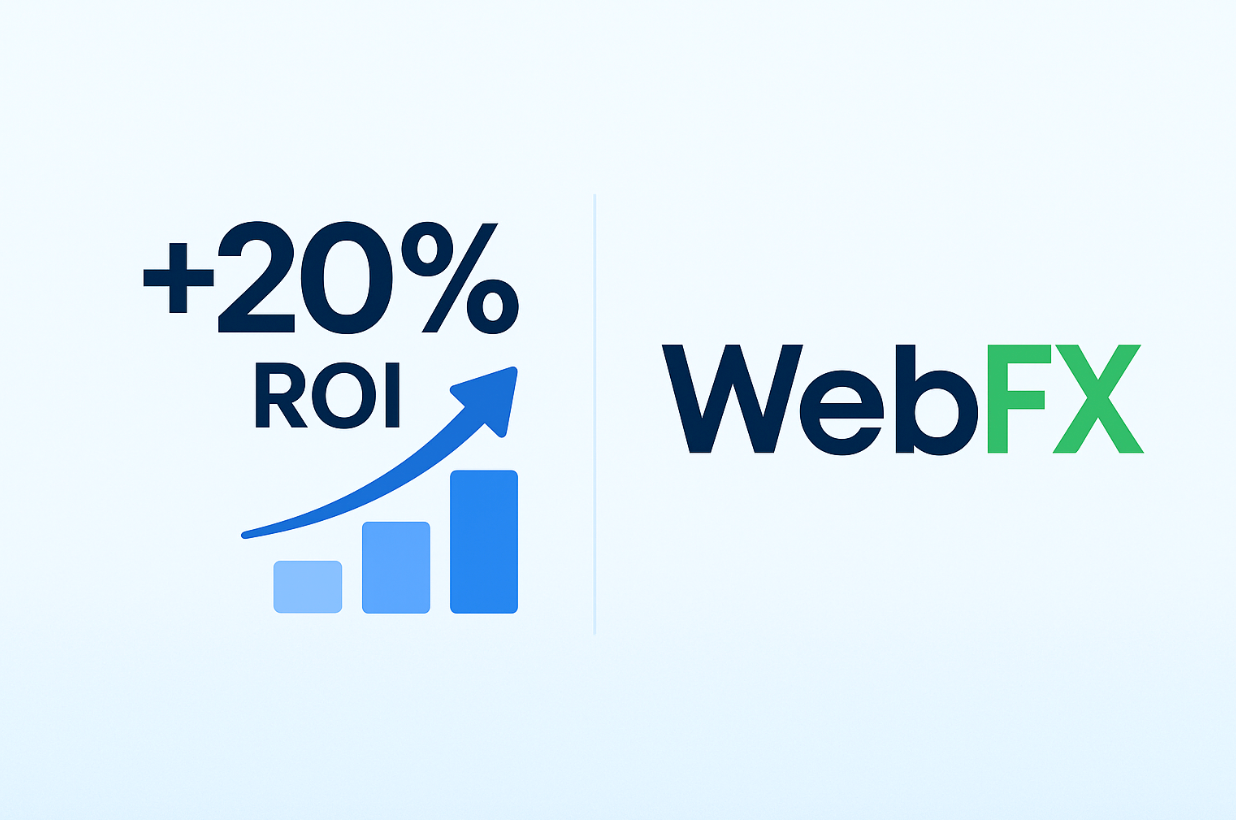
2. WebFX: AI-powered analytics meet human strategy
With 25 years in digital marketing and a proprietary platform called MarketingCloudFX, WebFX crunches billions of data points to spot cheaper paths to conversions. Their results prove it:
Proof in numbers
- Boss Mechanical cut organic cost per lead by 70 percent and grew total leads 65 percent after WebFX overhauled bidding rules and CRO elements, according to WebFX.
- PaulB Parts slashed cost per lead 23 percent and lifted ROI 150 percent year over year with a WebFX-managed PPC plus SEO program, according to WebFX.
How they do it
- IBM-powered predictive models inside MarketingCloudFX flag high-value audiences and bid ceilings in real time.
- An in-house CRO squad ships page variations within days, not weeks, so winning versions scale fast.
- PPC insights sync with SEO roadmaps, preventing paid spend on keywords you already rank for.
Clients monitor every click, cost, and sale in a live dashboard; when CAC drifts north, an account manager calls with next steps the same day. Packages start around $1,500 per month plus ad spend, and the mix of AI tooling and 500-person expertise feels more like renting a growth lab than hiring an agency. If you sell high-ticket products or navigate year-long sales cycles, WebFX’s data muscle and CRO speed can keep your CAC on a steady downward slope.
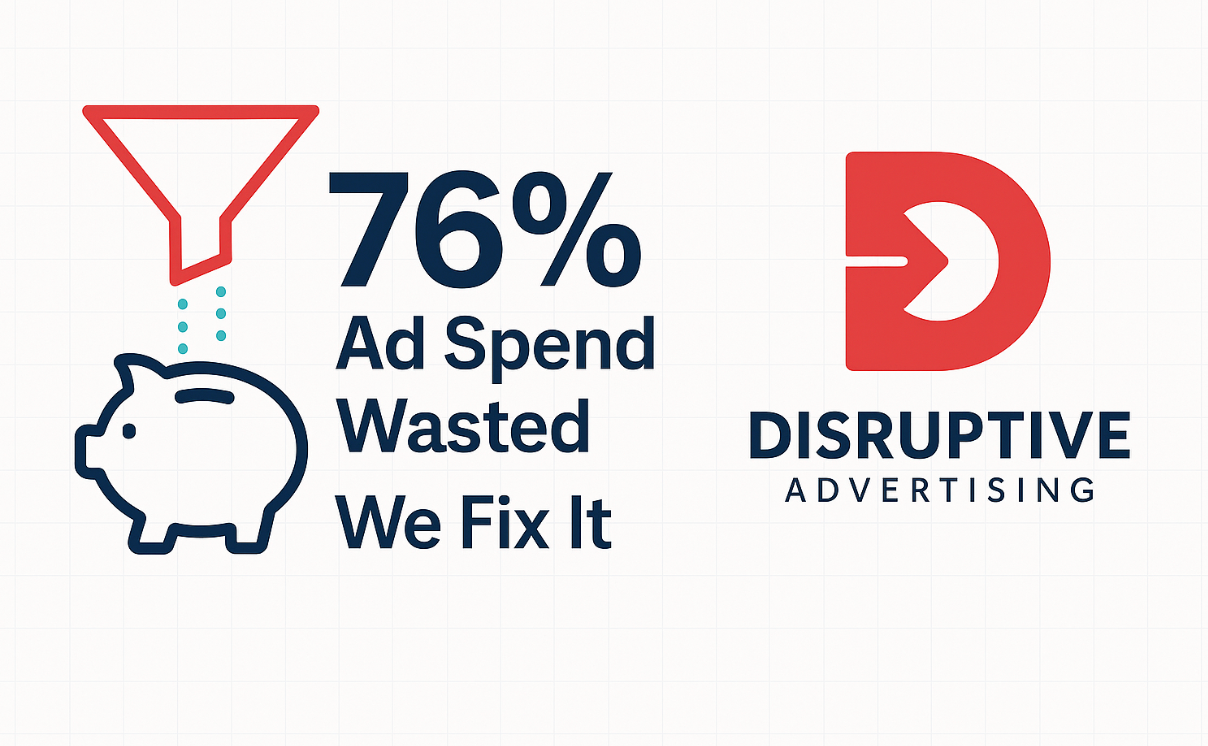
3. Disruptive Advertising: conversion first, budget second
Disruptive Advertising audits thousands of accounts each year and finds that 68 percent of ad spend is wasted before they step in. Their promise is clear: plug the leaks fast, then scale what works.
Proof in numbers
- A consumer-goods retailer cut cost per acquisition 32 percent and grew conversions 140 percent within six months after Disruptive rebuilt campaigns around high-intent keywords and YouTube remarketing (internal case study).
- Brands that qualify for Disruptive’s 30-day free strategy sprint see a measurable lift in ROAS within the first month, and they pay nothing if results fall short.
What makes them different
- A forensic kickoff audit highlights wasted spend and quick-win CRO fixes.
- PPC managers sit next to designers and UX analysts, so heat-map insights flow straight into bid strategy.
- A 90-day money-back guarantee puts pressure on the team, not your budget, to hit target CAC.
Contracts run month to month, which means Disruptive must beat yesterday’s numbers every 30 days. If you want a partner that pauses a leaking ad set before your next coffee and spins up a fresh test the same afternoon, this conversion-focused crew deserves a look.
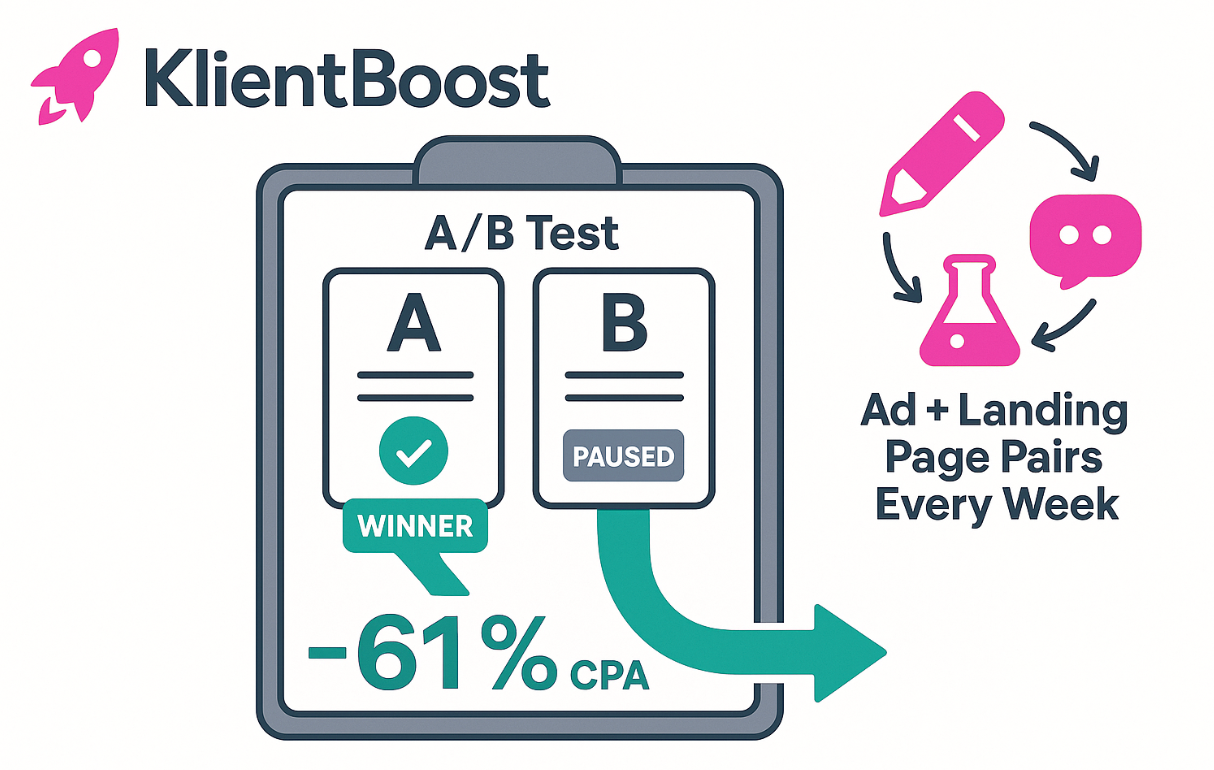
4. KlientBoost: creative firepower plus CRO cuts costs fast
KlientBoost treats every Google Ads campaign like a lab experiment, running hypotheses, rapid tests, and clear winner calls. That mindset pays off:
Proof in numbers
- A B2B SaaS client slashed cost per opportunity 61 percent after KlientBoost moved to single-theme ad groups, rewrote benefit-first headlines, and trimmed an 18-field form to three steps (internal client deck).
- Across 200 plus case studies the agency reports an average 63 percent ROI lift in the first three months of engagement, according to KlientBoost.
- Clutch reviewers echo the trend: one firm saw a 50 percent jump in conversions while cost per conversion fell 17 percent, according to Clutch.
Why it works
- One squad—designers, copywriters, and PPC strategists—ships new ad-and-landing-page pairs every week, keeping message match tight and Quality Scores high.
- Winners are promoted, losers are paused; no gray zone.
- Weekly test launches and bi-weekly performance recaps prevent creative fatigue and keep CAC trending down.
Engagements run on a flexible retainer that bundles paid media and CRO, so every dollar spent on traffic is backed by pages built to convert. If you thrive on curiosity and want proof that bold creative plus disciplined testing can melt acquisition costs, KlientBoost is your kind of lab.
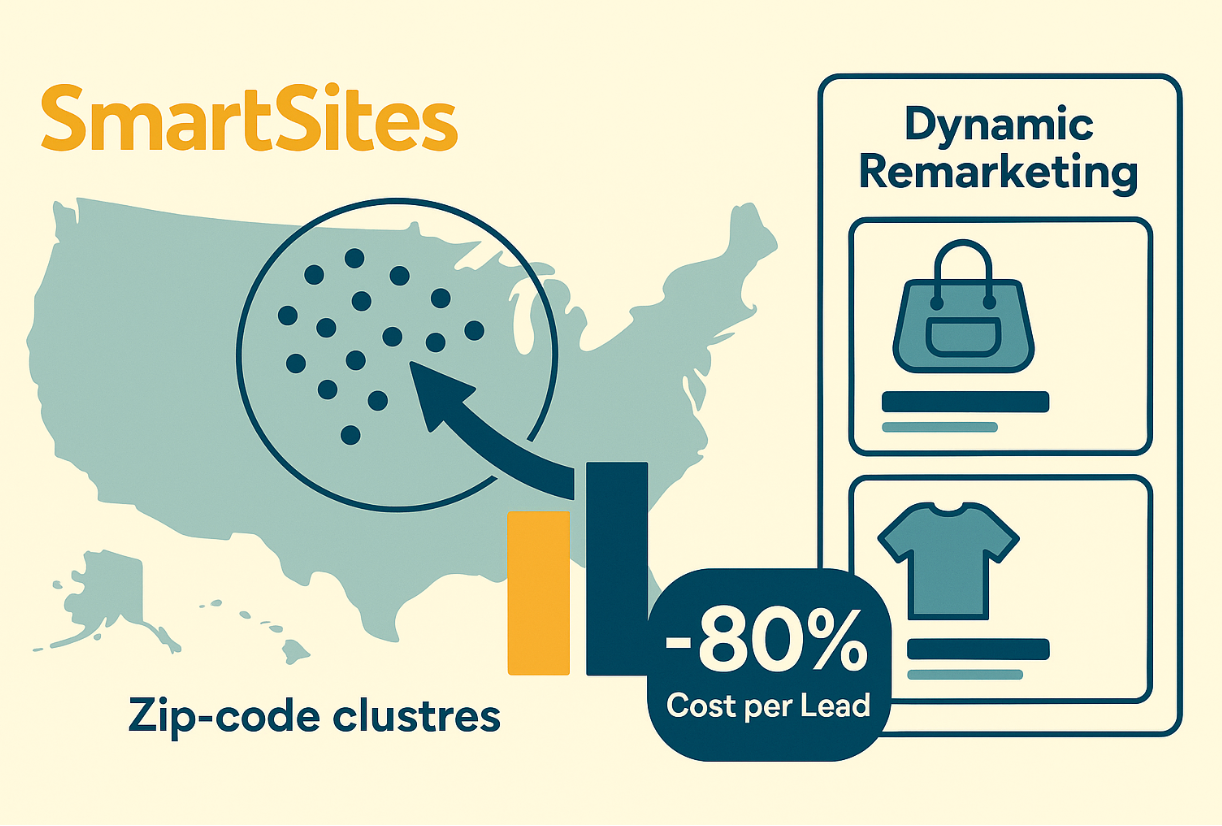
5. SmartSites: precision targeting for small-and-mighty budgets
SmartSites has earned seven consecutive Inc. 5000 appearances by helping small and mid-size businesses reach enterprise-level efficiency. Their edge lies in laser-focused geo, device, and demographic targeting paired with always-on remarketing.
Proof in numbers
- LA Colon & Rectal slashed cost per lead 80 percent and cut CPC 25 percent after SmartSites narrowed its radius to fifteen miles and launched medical-specific remarketing ads, according to SmartSites.
- An answering-service client grew qualified interactions 743 percent by pruning low-intent keywords and refining landing-page UX, according to SmartSites.
Why it works
- Zip-code clustering and income filters keep spend on audiences ready and able to buy.
- Dynamic remarketing matches each visitor’s last action—whether an abandoned cart, product page, or pricing sheet—turning warm traffic into conversions for pennies.
- Transparent month-to-month pricing (from about $1,000 in ad spend) lets SMBs scale without long-term risk.
If you want an agency that sweats every targeting toggle and treats remarketing like pure margin, SmartSites is a smart bet.
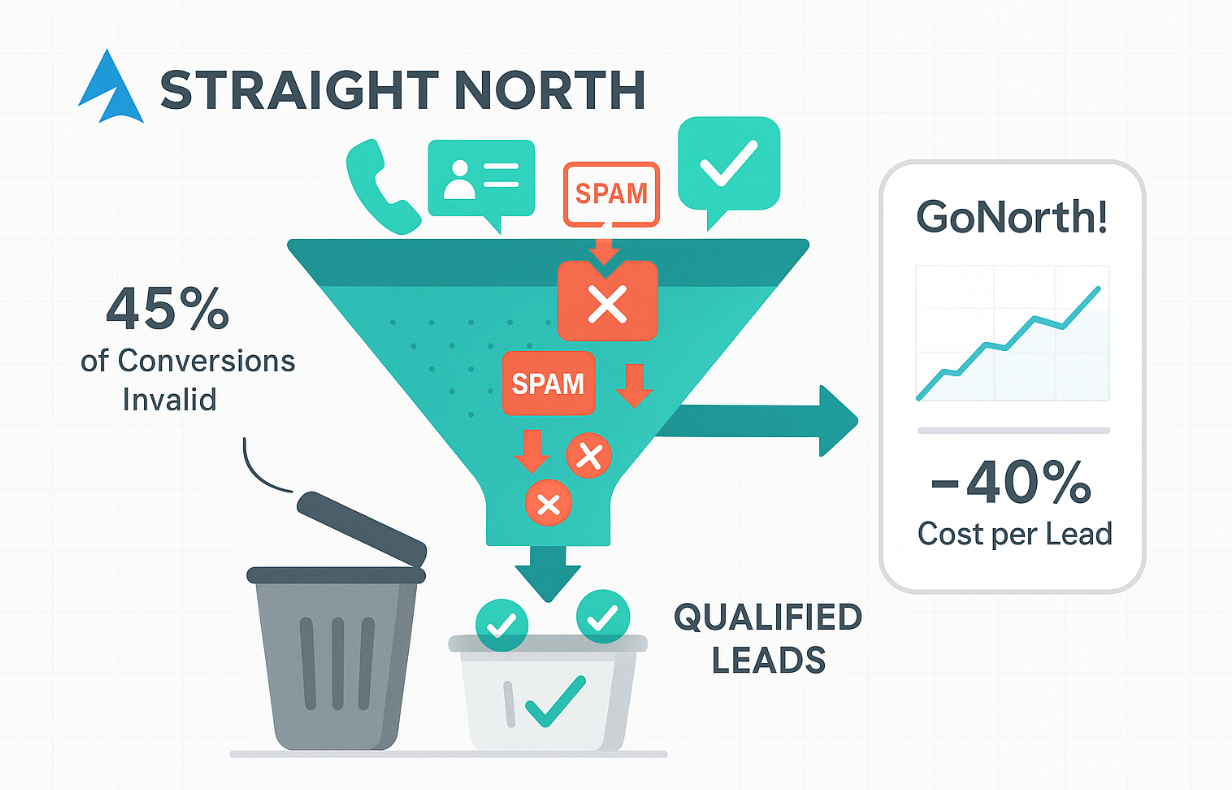
6. Straight North: custom lead validation that saves every dollar
Straight North reports that 45 percent of typical PPC “conversions” are not real sales leads; many are misdials, spam, or service calls. Their proprietary validation engine grades every form fill and phone call, so optimizations focus only on revenue-ready prospects.
Proof in practice
A Midwest industrial supplier segmented campaigns by product line, added day-parting around buyer work hours, and let validated-lead data drive bid rules. In twelve months, cost per true lead dropped 40 percent while qualified lead volume grew 233 percent (internal case study).
What makes them different
- GoNorth! dashboards tie each keyword to a verified lead, so low-quality queries pause fast.
- Geographic bid modifiers and custom landing pages ensure clicks match your distribution footprint.
- After a three-month ramp, contracts shift to flexible terms, and Straight North stays on the hook to keep CPL moving down.
If you need campaigns tuned to your exact sales process and a filter that blocks junk before it drains budget, Straight North makes every click earn its keep.
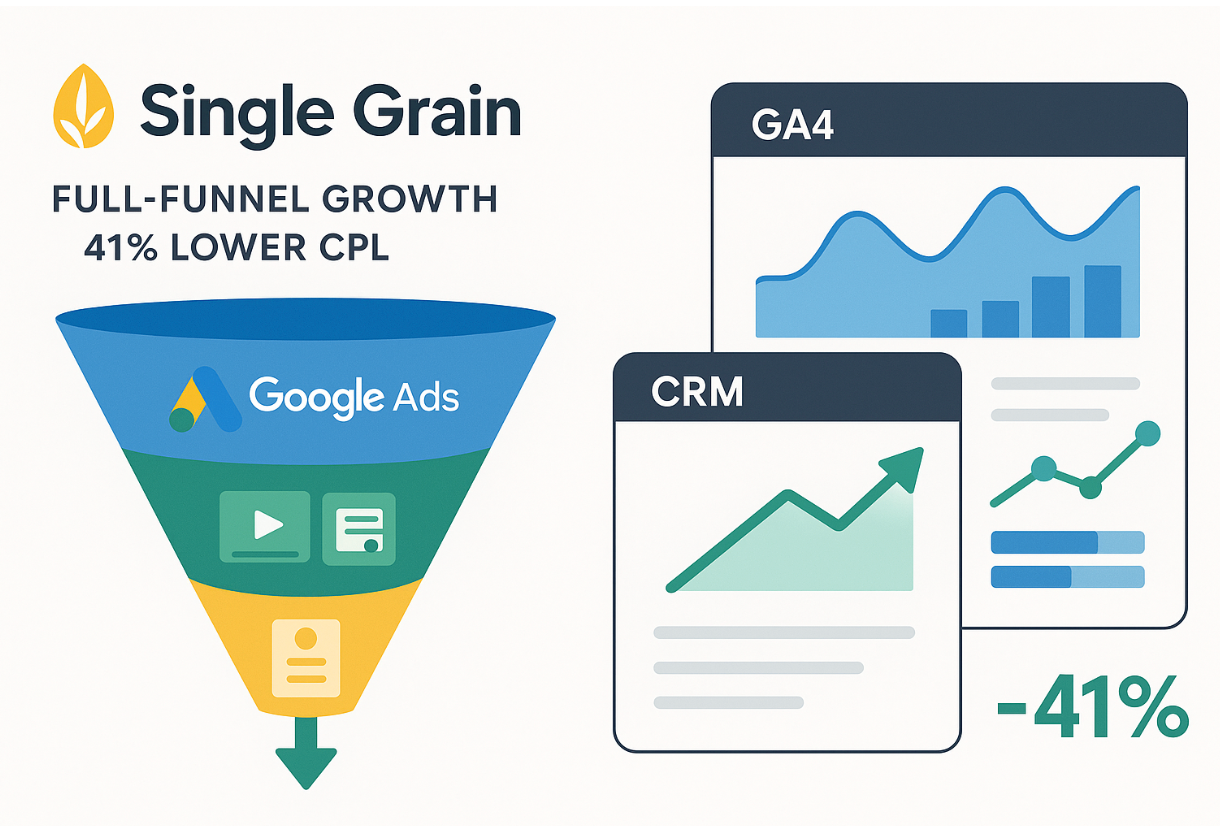
7. Single Grain: full-funnel growth for SaaS and tech brands
Single Grain sits where SEO, content, and paid media meet, making it ideal for software companies that need efficient scale. Led by marketer-podcaster Eric Siu, the Los Angeles team turns high-intent search clicks into nurtured, sales-ready leads.
Proof in numbers
- For Nextiva, Single Grain grew qualified leads 486 percent year over year while cutting cost per lead 41 percent by pairing Google Search with mid-funnel remarketing and content offers, according to Single Grain.
- A marketing-tech SaaS client tripled paid sign-ups and lowered blended CAC 20 percent in three months after Single Grain moved cold clicks into webinar and case-study nurture paths (internal summary).
Why it works
- Attribution discipline: GA4, CRM, and product-usage data reveal which keywords create the highest-LTV users, so budgets shift to those fast.
- Content-infused retargeting: evaluators see case-study teasers, ROI calculators, and webinar invites that warm them before the demo request.
- Quarter-to-quarter contracts give the team runway to iterate yet keep pressure on CAC goals every ninety days.
If your product requires education before purchase, Single Grain’s full-funnel choreography can lower acquisition costs while building a predictable pipeline.
FAQs
How soon can I expect CAC to drop after hiring an agency? Most see early wins in 30–60 days (post-audit quick fixes), with durable CAC improvements compounding over 90–120 days as tests roll and learnings stack.
What monthly ad budget makes agency management worthwhile? A common floor is ~$2,000–$5,000/month. Below that, fees can outweigh gains—ask for a free audit to confirm ROI potential before committing.
What should a solid Google Ads audit include? Clear findings on wasted spend (search terms/placements), Quality Score blockers, conversion tracking gaps, landing-page issues, and a 90-day test plan tied to target CAC.
How do I track CAC accurately from Google Ads? Connect ads → analytics → CRM. Count only qualified conversions (phone leads/forms vetted), include management fees in CAC, and segment by campaign/audience to spot outliers.
Is Performance Max good for lowering CAC? It can be—if fed strong assets, clean conversion goals, and brand/negative controls. Pair with search for intent capture and monitor placement insights to prevent waste.
Conclusion
Google Ads CAC climbed 13 percent year over year for the median advertiser, according to WordStream, yet the seven agencies above prove you can buck that trend. With tight strategy, persistent testing, and clear reporting, each one has cut acquisition costs—sometimes by half—while revenue rises.
What comes next?
- Audit your last ninety days of data. Flag keywords that earn profit, and tag those that drain the budget.
- Create a short-list of two or three agencies.
- Want month-to-month, no-contract help? PPC Masterminds.
- Need AI-driven analytics? WebFX.
- Prefer creative plus CRO muscle? KlientBoost.
- Value validated-lead focus? Straight North.
- Request a free or low-commitment review. Most firms here provide one; use it to reveal quick wins you can bank within weeks.
Keep standards high: live dashboards that show true CAC, weekly calls with next actions, and an experiment culture that never rests. When those pieces lock in place, Google Ads moves from unpredictable spend to a scalable growth engine.
Run the numbers, ask tough questions, and pick the partner who proves with data that “we’re spending too much” can become “we’re acquiring customers for less than ever.”

